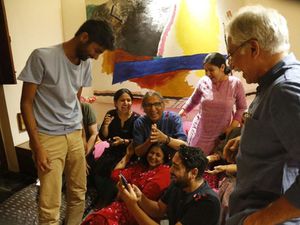India’s Balkrishna Doshi wins architecture prize for work with low-cost housing
The urban planner, whose work is almost exclusively in his homeland, was praised for respecting his country’s traditions.

Architect and educator Balkrishna Doshi, best-known for his innovative work designing low-cost housing, has been awarded the 2018 Pritzker Architecture Prize, the first Indian to win the industry’s highest honour in its 40-year history.
The award was announced on Wednesday by Tom Pritzker of the Chicago-based Hyatt Foundation.
Mr Doshi has been an architect, urban planner, and educator for 70 years.
The foundation called the 90-year-old’s work “poetic and functional”, and noted his ability to create works that both respect eastern culture and enhance quality of life in India.
Among Mr Doshi’s achievements are the Aranya low-cost housing project in Indore, which accommodates over 80,000 people, many of them poor, through a system of houses, courtyards and internal pathways.
Reached at home in the western city of Ahmedabad, Mr Doshi said his life’s work has been “to empower the have-nots, the people who have nothing”.
The housing itself, he said, can transform how residents see their world.
“Now, their life has changed. They feel hopeful,” he said.
“They have ownership of something.”

“What I have done for close to the last 60 years, working in rural areas, working in low-cost housing, worrying about India’s future.
“Now all this comes together and gives me a chance to say ‘Here we are!'” he said.
Mr Doshi was influenced early by two of the great 20th-century architects, Charles-Edouard Jeanneret, known as Le Corbusier, and Louis Kahn.
The prize citation noted how their influence “can be seen in the robust forms of concrete which he employed”.
“With an understanding and appreciation of the deep traditions of India’s architecture, he united prefabrication and local craft and developed a vocabulary in harmony with the history, culture, local traditions and the changing times of his home country India,” the citation read.
Mr Doshi’s work ranges from the Life Insurance Corporation Housing buildings in Ahmedabad to the naturalist curves of that city’s Amdavad ni Gufa underground art gallery.

While the work of Pritzker winners are often scattered across the globe, Mr Doshi is known for working almost completely in his homeland, designing buildings for government offices, companies and universities.
Born in 1927 in the city of Pune, Mr Doshi studied architecture in Mumbai and later worked under Le Corbusier, overseeing his projects in the cities of Chandigarh and Ahmedabad.
He founded his own practice in 1956, and lives and works in Ahmedabad.
Mr Doshi will be formally awarded the prize in a May ceremony at the Aga Khan Museum in Toronto.





